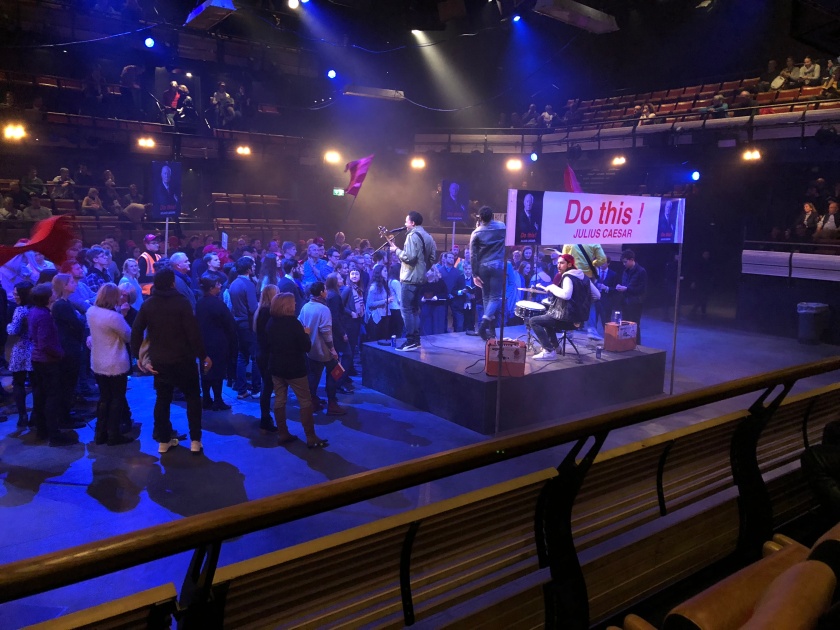The conference is an important marker of progress in any research project. It offers a forum in which new ideas can be tested and deepened through collaboration and discussion, and patterns and connections recognised and further explored.
Thanks to the speakers, and to other participants from our hosts at Florida State University’s Department of Classics, we felt that our conference delivered this. We were pleased to find links across papers on different authors and genres, bringing out common themes across time and connecting ancient and modern. There will be much more to come from the conference as we develop our papers and the connections they have forged, but this initial report aims to give some idea of the energy of the event itself.
The conference began with a brief welcome from project leader Tim Rood and collaborator John Marincola.
Snow in New York meant that there was not enough time for our first presenter, Constanze Güthenke, to reach us in person, but connected via Skype across space and time zones she was able to deliver a paper that explored the relationship between anachronism and exemplarity, a significant theme that would recur in other talks.
Mark Payne’s paper explored the temporality of post-apocalyptic fictions, from Hesiod to Mary Shelley’s The Last Man, exploring the persistence of classical motifs of destruction and the relearning of the skills necessary for human survival from Works and Days to contemporary speculative fiction.
Brooke Holmes explored the way in which ancient thinkers seek to connect themselves and their ideas to the past, even generating anachronisms in their interpretation of the work of predecessors. Her paper focused on this phenomenon in medical texts, particularly Galen’s reading of Hippocratic texts, but it may be a broader phenomenon of ancient intellectual history.
In exploring ancient use of the past as a means of providing authority and legitimation for new ideas, Brooke also provided an important reminder of the importance of understanding how these processes still operate, and particularly the political implications of claims to the authority of the classical past in the context of American history and the legacy of slavery and inequality.
Scarlett Kingsley looked at some of the earliest texts in which the language of anachronism makes an explicit appearance, late antique commentaries on classical texts surviving as comments in the manuscript tradition. Scholiasts struggled to interpret the temporality of tragedy, with its mixture of heroic myth and references to contemporary fifth-century Athenian political practices and concerns. Scarlett highlighted how such concerns often emerged as identification of transgressions of the boundaries of genre.
Emily Greenwood approached the temporality of Thucydides’ History through the idea of ‘literature as witness’, taking his reportage of the Athenian plague as a starting point. Writing as witness is key to modern construction of crisis; Emily read Ali Smith’s prose poem from her 2016 novel Autumn as an example written in response to the Brexit vote:
All across the country, there was misery and rejoicing.
All across the country, what had happened whipped about by itself as if a live electric wire had snapped off a pylon in a storm and was whipping about in the air above the trees, the roofs, the traffic.
Emily also emphasised the work on Nicole Loraux on anachronism and historical analogy.
Missing from the live-tweeting is Carol Atack’s own paper, ‘Plato’s Queer Time: Dialogic Moments in the Life and Death of Socrates’, which used queer theories of temporality to explore Plato’s use of affective and non-linear time in constructing his dialogues, and his affirmation of non-reproductive filiation in the relationships between educators and educated.
The second day began with a team photo:

The three remaining papers connected a wide range of ground, from ancient philosophy to contemporary politics via the romantic revolutionary spirit of Percy Shelley. Barney Taylor explored the highly self-conscious archaism of Lucretius’ verse as he interwove Greek philosophy and emerging traditions of Latin poetic form. Tom Phillips looked at Shelley’s reworking of the Homeric Hymn to Hermes as the Hymn to Mercury in the context of Shelley’s own dissatisfaction with the politics of Periclean Athens as a radical reception of the classical past.
Finally, Ellen O’Gorman discussed Jacques Rancière’s use of Tacitus’ history and Auerbach’s reading of it in his Mimesis to explore the way in which proletarian voices are included or excluded from historical narrative. Rancière’s thought on anachrony and the problem of identifying and describing intellectual and historical change had been a frequent point of reference throughout the conference, and this detailed reading was particularly helpful.
Ellen closed her paper with a look at the voice of the excluded in contemporary Dublin, through the rapper Tommy KD’s reading of the Irish Proclamation
Finally, John Marincola concluded the proceedings with some thoughts on Polybius’ cyclical view of history and change.
At the time that the conference was closing, many young people gathered outside FSU’s Westcott Center to march to the nearby State Capitol as part of the national March for our Lives. We were reminded of the role of Tallahassee’s students in previous campaigns for social change, such as the bus boycott begun by two students at the city’s Florida Agricultural and Mechanical University in May 1956.
That afternoon, we explored the deeper past of Florida, with a visit to the state park at Wakulla Springs, where animals and humans have been nourished for many millennia. We were thrilled to see alligators and manatees, in a beauty spot that has served as a film location (Tarzan, Creature from the Black Lagoon) for films that attempt to connect contemporary human life with the distant past, an extreme and in some cases problematic version of the contemporaneity of the non-contemporaneous.


